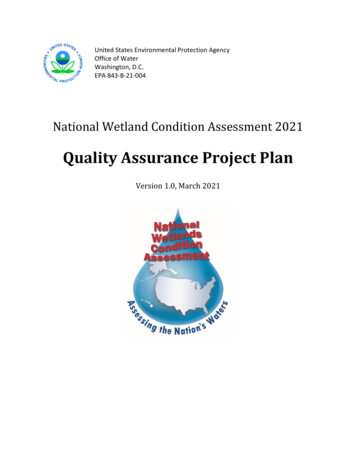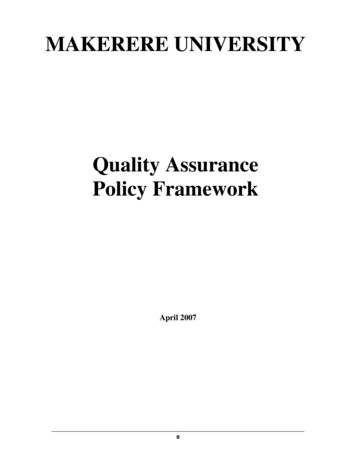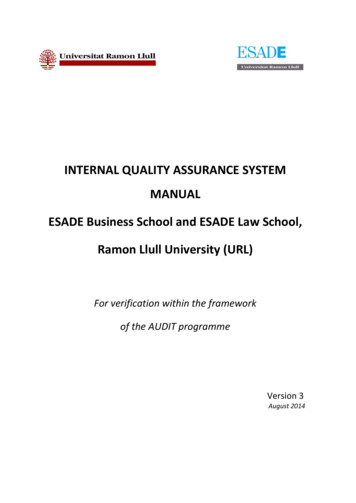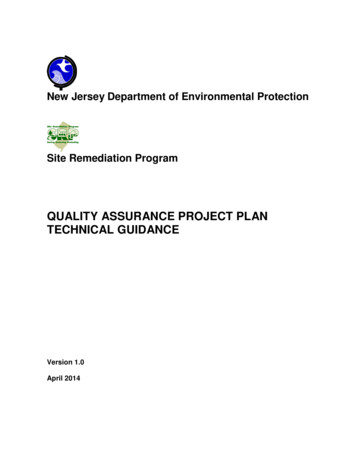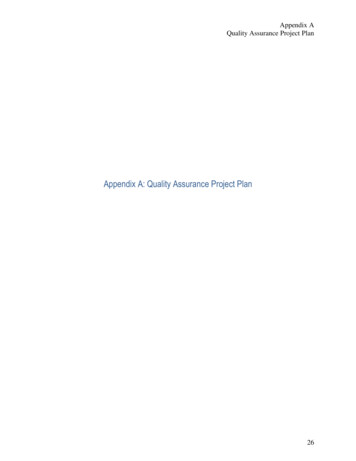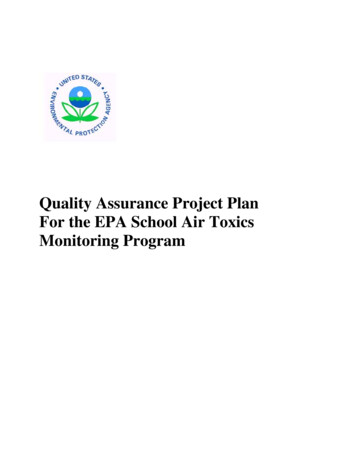
Transcription
Quality Assurance Project PlanFor the EPA School Air ToxicsMonitoring Program
July 2009Quality Assurance Project Plan for the EPASchool Air Toxics Monitoring ProgramCategory II QAPPU.S. Environmental Protection AgencyOffice of Air Quality Planning and StandardsAir Quality Assessment DivisionResearch Triangle Park, North Carolina, 27711
1.0 Signature PageRichard WaylandU.S. Environmental Protection AgencyOAQPS – AQAD DirectorDateLewis WeinstockU.S. Environmental Protection AgencyAmbient Air Monitoring Group LeaderDateMichael JonesU.S. Environmental Protection AgencyProgram ManagerDateDennis MikelU.S. Environmental Protection AgencyQuality Assurance Program CoordinatorDateJoseph ElkinsU. S. Environmental Protection AgencyOAQPS Quality Assurance ManagerDateA signed copy of this Quality Assurance Project Plan is stored in the Quality Assurance ProgramCoordinator’s office. Please see the contact in the Acknowledgement Section.i
AcknowledgementThis Quality Assurance Project Plan (QAPP) was developed internally by EPA’s Office of Air Quality Planning andStandards (OAQPS), Region 3 and Region 4. Additional material and text were provided by EPA’s Urban AirToxics Monitoring Program Contractor; Eastern Research Group (ERG). Text provided by ERG is noted throughoutthe document. For more information on ERG’s or its subcontractor’s QAPP or procedures, contact ERG directly at919-468-7800 or by email at http://www.erg.com/contact/res.htm.This QAPP was generated using the EPA QA regulations and guidance as described in EPA QA/R-5, EPARequirements for Quality Assurance Project Plans and the accompanying document, EPA QA/G-5, Guidance forQuality Assurance Project Plans. This is a Category II QAPP, is structured as such and has all pertinent elements of aCategory II QAPP, as suggested by the R-5 document. The R-5 guidance on developing QAPPs can be found athttp://www.epa.gov/quality/qa docs.htmlThere are several companion documents to this QAPP, the School Air Toxics Monitoring Plan, dated July 8, 2009,and several instrument Standard Operating Procedures (SOPs). Information on the school locations, description ofthe monitoring design, schedule and other information are included in the Monitoring Plan. These documents can bedownloaded at the following website: http://www.epa.gov/ttn/amtic/airtoxschool.htmlFor questions or comments please contact:Dennis Mikel, EPA-OAQPS-AQAD at mikel.dennisk@epa.gov or 919-541-5511Mike Jones, EPA-OAQPS-AQAD at jones.michael@epa.gov or 919-541-0528Lewis Weinstock, EPA-OAQPS-AQAD at weinstock.lewis@epa.gov or 919-541-3661ii
Acronyms and PDPM10PTQA/QCQAAir Pollution Control or Management DistrictAmerican National Standards InstituteAir Quality SystemAmerican Society for Testing and MaterialsClean Air ActCode of Federal Regulationschain of custodycoefficient of variancedata acquisition systemdi-nitro phenyhydrazinedata quality assessmentdata quality objectiveselectron capture – hall detectorenvironmental data operationEnvironmental Protection AgencyEastern Research Groupgas chromatography/mass spectrometrygeographical information systemsgeographic positioning systemhazardous air pollutantshigh pressure liquid chromatographyion coupled plasma/mass spectrometryInternational Standards OrganizationInternational Union of Pure and Applied Chemistsin-organiclocal area networklaboratory information management systemminimum detection limitmeasurement quality objectivesNational Air Toxics AssessmentNational Air Toxics Trends StationsNational Institute of Occupational Safety and HealthNational Institute of Standards and TechnologyNational Weather ServiceOffice of Air Quality Planning and StandardsOccupational Safety and Health Administrationpolycyclic aromatic hydrocarbonspersonal computerpercent differenceparticulate matter – 10 micronsproficiency testingquality assurance/quality controlquality assuranceiii
Acronyms and SPUATMPUVVOCquality assurance final reportquality assurance managerquality assurance project planquality controlRisk-Screening Environmental IndicatorsSchool Air Toxics Monitoring ProgramState/Localstandard operating proceduretechnical assistance documenttoxic organictechnical system audittotal suspended particulatesUrban Air Toxics Monitoring Programultra-violetvolatile organic compoundiv
512-113-117-1DescriptionPage No.List of Methods and Target AnalytesAssessment ScheduleSchedule of Critical SATMP ActivitiesMQOs for MetalsMQOs for VOCsMQOs for other compoundsSATMP Data and Records StorageScheduled Monitoring ActivitiesList of Target AnalytesSample Setup, Run and Recovery DatesField SuppliesTemperature RequirementsHolding TimesSample Invalidation Criteria for Collocated DataInspections in the LaboratoryAssessment Summaryv7101119192021232627283030444658
FiguresFigure No.3-110-110-210-3DescriptionPage No.Overall Structure of the SATMPUATMP Sample Data SheetCanister TagCarbonyl Chain of Custody Formvi1323334
2.0 Table of ContentsSectionPage1.0 Signature PageiAcknowledgementiiAcronyms and AbbreviationsiiiList of TablesvList of Figuresvi2. 0 Table of Contentsvii3.0 Project/Task Organization13.1Roles and Responsibilities13.2 Sampling Frequency, Duration, and Quantity44.0 Problem Definition/Background54.1 Problem Statement and Background54.2 Project Monitoring Design54.3 Locations of Interest for the SATMP75.0 Project Task/Description85.1 Overview of Field Activities85.2 Overview of Laboratory Activities95.3 Project Assessment Techniques105.4 Schedule of Activities106. 0 Data Quality Objectives136.1 The DQO Process136.2 State the Problem146.3 Identify the Decision146.4 Identify the Inputs to the Decision156.5 Define the Study Boundaries156.6 Develop a Decision Rule166.7 Specify Tolerable Limits on the Decision Errors166.8 Optimize the Design for Obtaining Data176.9 DQOs for the SATMP17vii
PageSection7.0 Documentation and Records217.1 Routine Record Data Activities217.2 EPA Data and Document Control227.3 Data Report, Archiving and Retrieval228.0 Sampling Design238.1 Scheduled Project Activities, Including Measurement Activities238.2 Rationale for the Design238.3 Design Assumptions248.4 Procedure for Locating and Selecting Environmental Samples258.5 Classification of Measurements as Critical/Noncritical259.0 Sampling Methods Requirements269.1 Purpose/Background269.2 Sample Collection and Preparation269.3 Support Facilities for Sampling Methods279.4 Sampling/Measurement System Corrective Action289.5 Sampling Equipment, Preservation, and Holding Time2910. Sample Handling and Custody3110.1 Sample Custody3110.2 Carbonyl Sample Custody3310.3 Sample Custody for other HAPs3510.4 Analytical Laboratory Data3510.5 Sampling Monitoring Data3511.0 Analytical Methods Requirements3611.1 VOC Canister Analysis and Cleanup System3611.2 Analysis of PAH using EPA Compendium TO-13A3811.3 Metals Using ICP/MS3811.4 Hexavalent Chromium3911.5 Diisocyanates3911.6 4,4 Methylene dianiline4011.7 Carbonyls40viii
PageSection12. 0 Quality Control Requirements4112.1 QC Procedures4113.0 Instrument/Equipment Testing, Inspection, and Maintenance4513.1 Purpose/Background4513.2 Testing4513.3 Inspection4513.4 Maintenance4614.0 Instrument Calibration and Frequency4814.1 Analysis of Instruments – Laboratory4814.2 Field Calibrations4914.3 Calibration Method4914.4 Calibration Standard Materials and Apparatus5015.0 Data Acquisition Requirements5215.1 Acquisition of Non-Direct Measurement Data5216.0 Data Management5416.1 Background and Overview5416.2 UATMP Contract Data Management5416.3 Data Tracking5616.4 EPA Data Reporting Requirements5616.5 EPA OAQPS Data Management5717.0 Assessment and Response to Action5817.1 Project Planning and Assessment Activities5918.0 Reports to Management6118.1 QA Final Report6119.0 Data Review6219.1 Data Review Design6219.2 Data Review6319.3 Data Verification6319.4 Data Reduction, Validation and Reporting64ix
SectionPage20.0 Data Validation, Verification and Analysis6520.1 Process for Validating and Verifying Data6520.2 Data Analysis6521.0 Reconciliation with Data Quality Objectives6721.1 Reconciling Results with DQOs6721.2 Five Steps of DQA Process67Appendix A: Schools Air Toxics Ambient Monitoring Plan, dated July 8, 2009x
SATMP QAPPRevision No: 4.9Date: 07/09Page 1 of 683.0 Project/Task Organization3.1 Roles and ResponsibilitiesEPA’s Office of Air Quality Planning and Standards (OAQPS) and the EPA Regional Officesare responsible for developing and implementing the Schools Air Toxics Monitoring Program(SATMP) with its partners in the State air agencies or Local (S/L) Air Pollution Control orManagement Districts (APCDs). The S/L APCDs and EPA Regional Offices are alsoresponsible for implementing the deployment and operation of monitors and, in some cases, thelaboratory analysis of samples for the program. It is the responsibility of both EPA and theStates and Local APCDs to assess the quality of the data and take corrective action whenappropriate. The responsibilities of each organization are addressed here. Figure 3-1 representsthe organizational structure of the SATMP.Figure 3-1 Overall Structure of the SATMP
SATMP QAPPRevision No: 4.9Date: 07/09Page 2 of 683.1.1 Office of Air Quality Planning and StandardsEPA OAQPS is charged under the authority of the Clean Air Act (CAA) to protect and enhancethe quality of the nation’s air. OAQPS sets national emissions standards for air toxics byindustry group, and works with states and local agencies to monitor these pollutants which areconsidered harmful to public health or welfare. OAQPS evaluates the need to regulate potentialair pollutants, especially air toxics, and develops national standards and works with S/L APCDsto develop plans for meeting these standards.Here are some of the roles and responsibilities for OAQPS in the SATMP; Take the lead role in implementing the program;Establish “a cross-Agency strike team” to implement the program;Examine available information from external and internal sources to create the list ofschools that require monitoring;Ensure that the methods and procedures used in making air pollution measurements areadequate to meet the programs objectives and that the resulting data are of satisfactoryquality;Communicate technical information to the Regions and the S/L APCDs;Provide up-front support (i.e., equipment acquisition and procure laboratory support);Evaluate the performance, through Technical Systems Audits (TSAs) of laboratoriesmaking air pollution measurements;Render technical assistance to the EPA Regional Offices and air pollution monitoringcommunity; and,Provide analysis and interpretation of the results and communicate those results to theEPA Administrator and the public at large.3.1.2 EPA Regional OfficesThe EPA Regional Offices will address environmental issues related to the States within theirjurisdiction and administer the program. The major quality assurance (QA) responsibilities ofEPA's Regional Offices, in regards to the SATMP, are the coordination of field and in somecases the laboratory quality control (QC) and QA matters at the Regional levels with the S/Lagencies. The EPA Regional Offices are responsible for some of the technical aspects of theprogram including: Reviewing and guiding the program goals;Reviewing and developing the QAPP;Evaluating quality system performance, through TSAs (if needed) and network siting andreviews; and,
SATMP QAPPRevision No: 4.9Date: 07/09Page 3 of 68 Acting as a liaison by making available the technical and quality assurance informationdeveloped by EPA Headquarters and the Region to the S/L APCDs, and making EPAHeadquarters aware of any the unmet quality assurance objectives.3.1.3 States and Local APCDsThe major responsibility of S/L APCDs is the implementation of a satisfactory monitoringprogram, which would naturally include the implementation of an appropriate QA/QC program.It is the responsibility of S/L agencies to implement QA/QC programs in the field portion of thisprogram, in their own laboratories, if utilized, and in any consulting and contractor laboratorieswhich they may use to obtain data or information. Here is a list of some of the responsibilitiesof the S/L APCDs; Work closely with EPA OAQPS/Regional staff and school staff to site the monitoringstations;If utilized, procure laboratory services to analyze the data;Receive and inspect unexposed samples to make sure they are ready for sampling;Operate the monitoring samplers according to the schedule stated in this QAPP;Ship the exposed samples to the laboratory performing the analysis;Participate in the screening and analysis of the data, and;In co-ordination with EPA, communicate with the schools and public about the results;and,Follow the field approved field SOPs when operating monitors.3.1.4 Laboratory ContractorThe SATMP requires that air toxic samples be analyzed in accordance to strict QA/QCrequirements as defined in Section 6.9. At this time, the EPA recommends that all samples beanalyzed by OAQPS’ Urban Air Toxics Monitoring Program (UATMP) contract laboratory. Itis possible that several S/L APCDs may decide to analyze the samples with the laboratoriesunder their jurisdiction. If this is the case, then the S/L laboratories must meet the requirementsas stated in Section 6.8. Demonstration of their ability to be able to meet the MeasurementQuality Objectives (MQOs) is required before S/L agencies can analyze samples for thisprogram. OAQPS will review each laboratory’s capabilities on a case by case basis. S/Llaboratories will participate in an independent laboratory Technical System Audit (TSA)and analyze Proficiency Testing (PT) samples before analysis can be performed for thisprogram.
SATMP QAPPRevision No: 4.9Date: 07/09Page 4 of 68Here is a partial list of the laboratory duties: Sending sample containers/filters to the field operators, following strict requirements onshipping and handling according to their Standard Operating Procedure (SOPs);Receiving samples from the field;Analyzing the samples relative to their QA/QC procedures and SOPs;Performing data validation procedures on the data;Troubleshooting and repairing any laboratory instruments that malfunction; and,Reporting all data to EPA as required.The UATMP contractor does not have the ability to do certain analyses, such as theDiisocyanates and 4,4 Methylene dianiline, which are discussed later. Therefore, the UATMPcontractor will subcontract these analyses. Samples that must be analyzed by the subcontractorwill be shipped directly to the subcontract laboratory to expedite the analyses. It is the UATMPcontractor’s responsibility to get data and information from the subcontractor in a timelymanner and to maintain adherence to required chain of custody and other proceduralrequirements.3.2 Sampling Frequency, Duration, and QuantityAmbient air sampling shall be conducted on a 1 in 6 day schedule, details of which must becoordinated with the EPA and national contract laboratory. Start dates will vary by site as afunction of monitoring setup completion. Once monitoring operations have commenced, thebase (i.e., minimum duration) sampling period is 60 days; given a 1 in 6 sampling schedule, thebase sampling period is intended to result in 10 valid samples. There may be cases in which the60 day sampling period is deemed to be insufficient (e.g., invalidated sample(s), insufficientlyrepresentative data, etc.) and thus extended, typically not to exceed a total duration of 90 days.A companion document to this QAPP, the “Schools Air Toxics Ambient Monitoring Plan,dated July 8, 2009” (hereby known as The Monitoring Plan) has detailed information insection 3.2. The S/L APCDs are authorized to collect up to three additional random samples thatwill be set and run at the discretion of the S/L APCDs. Details on this are also in Section 3.2 ofthe Monitoring Plan. The Monitoring Plan can be downloaded from the following html.
SATMP QAPPRevision No: 4.9Date: 07/09Page 5 of 684.0 Problem Definition/Background4.1 Problem Statement and Background4.1.1 IntroductionEPA will monitor air quality at a number of schools as part of an initiative to understandwhether outdoor toxic air pollution poses health concerns to schoolchildren. This qualityassurance plan addresses one aspect of the initiative; ambient air monitoring.EPA developed a list of priority schools for an initial round of monitoring that is expected tolast a minimum of 60 days. The agency selected the schools using EPA’s National Scale AirToxics Assessment (NATA), results from a USA Today analysis, which is based on EPA’sRisk-Screening and Environmental Indicators (RSEI) model and after consulting with state andlocal air agencies.4.1.2 Project ObjectivesThis ambient air monitoring exercise will yield data of sufficient quality that allow apreliminary assessment of any potential air toxics impacts specific to the school at which themonitoring occurred. This preliminary assessment will be used to determine subsequent stepsthat may include:1) Terminating monitoring where assessments indicate low impacts,2) Pursuing long-term emission and risk reduction activities (such as enforcement orother actions) where monitoring data show potentially unacceptable impacts, or3) Considering longer-term monitoring where initial data are inclusive and additionalinformation is needed to better characterize the potential for impacts4.2 Project Monitoring Design4.2.1 Meteorological MeasurementsSite specific meteorological parameters that will be measured consist of wind speed anddirection data. The type of sensor provided will be of sufficient quality for its intended use.OAQPS is purchasing sonic anemometers and data acquisition systems that will be able tocollect both scalar and vector data. Meteorological information is gathered from the NationalWeather Service (NWS) stations across the nation. Parameters include: temperature, relativehumidity, barometric pressure, rainfall, wind speed, wind direction, cloud type/layers, cloudcover and visibility range. OAQPS staff will retrieve data on temperature and rainfall from
SATMP QAPPRevision No: 4.9Date: 07/09Page 6 of 68NWS sites near the schools being monitored, to supplement the at-school wind speed and winddirection data for purposes of interpreting the air quality monitoring results.4.2.2 Hazardous Air PollutantsThere are currently 187 hazardous air pollutants (HAPs) and pollutant classes that are regulatedunder the Clean Air Act (CAA). These pollutants, often called air toxics, have been associatedwith a wide variety of adverse health effects, including cancer, neurological effects,reproductive and developmental effects. Air toxics are emitted from multiple sources, includingmajor stationary, area, and mobile sources, resulting in population exposure to these air toxicsas they occur in the environment. While in some cases the public may be exposed to anindividual HAP, people more typically experience exposures to multiple HAPs from manysources.Table 4-1 lists the “classes” of compounds that will be measured in the SATMP. For moreinformation on the instruments that will be used to collect these samples, please seeTable 4-1 lists the analytes by chemical class or group. Current information indicates thatspecific pollutants in these groups may be present at the schools. While we are focusing oureffort on monitoring for specific pollutants, the measurement methods used for certain classesof pollutants will detect other chemicals as well. For instance, under the class of compoundsknown as “VOCs,” benzene is a pollutant that may be present at certain schools. When thelaboratory performs the analysis for benzene, there are a number of other compounds that canbe analyzed, such as 1, 3 butadiene. This situation exists for the other classes of compounds aswell. We will report concentrations for all chemicals detected.The Monitoring Plan has the full list of compounds that will be evaluated by the methodschosen by this program. Please note that the pollutants of interest for this program are listed inSection 6.9, Tables 6-1through 6-3.
SATMP QAPPRevision No: 4.9Date: 07/09Page 7 of 68Target AnalytesVOCsCarbonylsPM10/TSP HAP MetalsMethodEPA TO-15EPA TO-11AEPA IO-3.5Sampling MediaAir (via canister)DNPH-coated silica gel cartridge47mm Teflon and 8” x 10”quartz filtersHexavalent ChromiumPAHsEPA-modified CARB 039TO-13A47mm acid-washed sodium bicarbonateimpregnated cellulose filterPUF / XAD-24,4 Methylene dianilineNIOSH No. 5029DiisocyanatesOSHA No. 42MeteorologySonic AnemometryTable 4-1 List of Methods and Target AnalytesSulfuric acid treated glass fiber filterglass fiber filter coated with1-(2-pyridyl)piperazineWind speed and direction scalar and vectordata4.3 Locations of Interest for the SATMPAs stated in the introduction of this section, the main goal of the SATMP is to monitor forspecific compounds in the outdoor air around the listed schools.
SATMP QAPPRevision No: 4.9Date: 07/09Page 8 of 685.0 Project Task/DescriptionThe measurement goal of the SATMP is to estimate the concentration, in standard units ofmicrograms per cubic meter (ug/m3), nanograms per cubic meter (ng/m3) and parts perbillion/volume (ppbv) of air toxic compounds of particulates and gases at the listed schools.This is accomplished by several separate collection media and analytical techniques. Activitiesfor this program are divided into two separate, yet linked activities: field monitoring andlaboratory analysis. An overview of the program follows.5.1 Overview of Field ActivitiesAmbient air sampling devices will be placed at secure monitoring locations on or near schools.Table 4-1 lists the methods and sampling media used for this program. The Monitoring Plan hasthe instrument specifications necessary for this program. Appendix A of the Monitoring Planlists the schools and the pollutants to be monitored. In most cases, the sampling will occur for24 hours /- 1 hour, with the exception of Diisocyanates and 4,4 Methylene dianiline. Theschedule and timing are discussed in detail in Section 9.2.2 of this QAPP.All of the instruments operated in the field are vendor supplied. The samplers utilized for thisprogram are similar to the instruments described in the Reference Section at the end of thischapter. All of the equipment will be supplied by vendors that specialize in manufacturing thesecollection devices.Training – EPA is partnering with experienced S/L APCDs to conduct the ambient monitoringaspect of the school air toxics program. EPA expects that monitoring agencies will assignexperienced personnel to operate sampling equipment, and that each agency’s prior experiencein operating similar criteria pollutant and/or air toxics monitors will provide adequate training toensure proper operation of equipment during this program. EPA will survey participatingmonitoring agencies (through Regional Office contacts) to confirm availability of trainedpersonnel, and will support individualized training needs as appropriate, coordinated throughvisits by Regional Office or Laboratory personnel. In addition and prior to the commencementof sampling, EPA will support one or more monitoring-focused national conference calls toprovide opportunities for agency’s to ask clarifying questions and to ensure a commonunderstanding of procedural requirements and expectations.Standard Operating Procedures (SOPs) - EPA will provide field SOPs for each of themethods being deployed in the schools monitoring program, complimenting the existinglaboratory SOPs that have been developed by EPA’s analysis contractor. Field SOPs will becompleted once the exact type(s) of samplers being procured is established through thecontractual process. At that time, field SOPs will be distributed to participating agencies andone or more conference calls will be supported to ensure a complete understanding of the
SATMP QAPPRevision No: 4.9Date: 07/09Page 9 of 68requirements by the individual site operators. EPA personnel will be available throughout theduration of the study to answer site-specific questions and/or handle other operational issuesthat may arise that may not be specifically described in the field SOPs.5.2 Overview of Laboratory ActivitiesLaboratory activities for the SATMP include preparing the samples, shipping/receiving, andanalysis. Here some activities associated with these phases.Pre-Sampling Receiving filters, canisters or cartridges from the vendors;Checking sample integrity;Conditioning filters, storing canisters and cartridges;Storing samples prior to field use;Packaging filters, canisters and cartridges for field use;Associated QA/QC activities;Maintaining analytical equipment at specified environmental conditions; and;Equipment maintenance and calibrations.Shipping/Receiving Receiving filters, canisters and cartridges from the field and logging into database;Storing filters, canisters and cartridges; and,Associated QA/QC activities.Post-Sampling Checking filter, cartridge and canister integrity and assigning unique codes;Extraction of VOCs from canisters;Extraction of Teflon, quartz and glass fiber filters;Extraction of Di-nitro phenyl-hydrazine (DNPH) bound compounds;Extraction of Polyurethane Foam (PUF) and XAD-2 resin;Analysis of samples extracted;Data entry/upload to the Air Quality System (AQS) database;Storing filters/archiving;Cleaning canisters; and,Associated QA/QC activities and data reporting.The details for these activities are included in various sections of this document, the laboratorySOPs, and References 1- 8.
SATMP QAPPRevision No: 4.9Date: 07/09Page 10 of 685.3 Project Assessment TechniquesAn assessment is an evaluation process used to measure the performance or effectiveness of asystem and its elements. For this program, assessment is used to denote any of the followingactivities: Network Siting and Review, Proficiency Testing (PT) and Technical System Audits(TSAs). Section 17 will discuss the details of the SATMP assessments.Table 5.1 provides information on the parties implementing the assessment and their frequency.Assessing AgencyType of AssessmentAgency AssessedFrequencyEPAPTsUATMPLaboratory andtheir subcontract labAt thebeginning ofthe programEPATSAsUATMPLaboratory andtheir subcontractorAt thebeginning ofthe programRegional OfficesNetwork Siting and ReviewS/L agenciesAt thebeginning ofthe programTable 5-1 Assessment Schedule5.4 Schedule of ActivitiesTable 5-2 contains a general list of the activities that will occur during this program. Pleasenote that the dates of these activities may change due to unforeseen circumstances. However,this is the general timeline for this program.
SATMP QAPPRevision No: 4.9Date: 07/09Page 11 of 68ActivityDue DateCommentsEvaluate the USA Today Network ListFebruary 2009List evaluation.Development of the EPANetwork ListFebruary 2009List of candidate schools developed considering USA Today analysis, NATA results, TRI data, and information from S/Lagencies.EPA Network List FinalizedMarch 2009List vetted through internal and S/L channels.DQO Process PerformedMarch 2009Monitoring, Analysis staff convene to develop DQOs.QAPP DevelopmentMarch 2009Input taken and incorporated into official document.Monitoring Plan DevelopmentMarch 2009Monitoring Plan vetted through official channels.Lab Services ProcuredMarch 2009UATMP services in place for receiving samples.Sampler siting/testingApril 2009Establishment of sites and preliminary testing of samplers.QAPP FinalizedJuly 2009QAPP finalized and submitted to S/L agencies.Field TrainingApril – May 2009Field and laboratory training activities and certification.Sampling BeginsApril- May 2009Sampler testing completed and media shipped to monitoringlocations.Laboratory Analysis BeginsApril-May 2009Samples received and analysis begins.Sampling EndsJuly – August 2009If 100% data capture is obtained, samplers are shut down.Data Analysis Phase BeginsJuly 2009Data loaded into AQS database and data are accessible to analyticalteam.Table 5-2 Schedule of Critical SATMP ActivitiesReferences:1. Compendium Method for the Determination of Inorganic Compounds in Air, United StatesEnvironmental Protection Agency, June 1999, Section IO-3.5http://www.epa.gov/ttn/amtic/inorg.html2. Compendium Method for the Determination of Toxic Organic Compounds in Air, United StatesEnvironmental Protection Agency, Section TO-15, January 1999http://www.epa.gov/ttn/amtic/airtox.html
SATMP QAPPRevision No: 4.9Date: 07/09Page 12 of 683. Compendium Method for the Determination of Toxic Organic Compounds in Air, United StatesEnvironmental Protection Agency, Section TO-11A, January 1999http://www.epa.gov/ttn/amtic/airtox.html4. OSHA Method 42, 2/org042.html5. NISOH Method 5029: ndium Method for the Determination of Toxic Organic Compounds in Air, United StatesEnvironmental Protection Agency, Section TO-13A, January 1999http://www.epa.gov/ttn/amtic/airtox.html7. Standard Operating Procedure for the Determination of Hexavalent Chromium in Ambient AirAnalyzed by Ion Chromatography (IC) developed for US EPA by Eastern Research Group,http://www.epa.gov/ttn/amtic/airtox.html8. Quality Assurance Handbook for Air Pollution Measurement Systems – Volume IV:Meteorological Measurements Version 2.0, 2008, http://www.epa.gov/ttn/amtic/met.html
SATMP QAPPRevision No: 4.9Date: 07/09Page 13 of 686.0 Data Quality ObjectivesThe primary objective of the project is as follows:The primary objective for this project is to collect information on ambient air concentrationsof target compounds at a s
This Quality Assurance Project Plan (QAPP) was developed internally by EPA's Office of Air Quality Planning and Standards (OAQPS), Region 3 and Region 4. Additional material and text were provided by EPA's Urban Air Toxics Monitoring Program Contractor; Eastern Research Group (ERG). Text provided by ERG is noted throughout the document.

